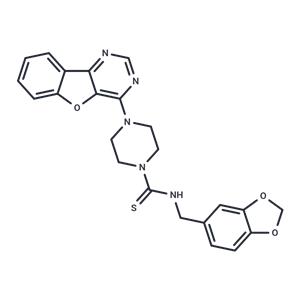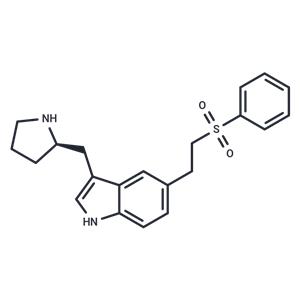
Amuvatinib NEW
| Price | $44 | $62 | $93 |
| Package | 1mg | 2mg | 5mg |
| Min. Order: | |
| Supply Ability: | 10g |
| Update Time: | 2025-07-15 |
Product Details
| Product Name: Amuvatinib | CAS No.: 850879-09-3 |
| Purity: 98.48% | Supply Ability: 10g |
| Release date: 2025/07/15 |
Product Introduction
Bioactivity
| Name | Amuvatinib |
| Description | Amuvatinib (MP470) is an orally bioavailable synthetic carbothioamide with potential antineoplastic activity. |
| Cell Research | Cells are plated at a density of 2 × 103 to 1 × 104 cells per well in 100 μL medium on day 0 in 96-well Falcon microtitier plates. On day 1, ten μL of serial dilutions of MP-470 are added to the plates in quadruplicates. After incubation for 4 days, the cells are fixed with 10% Trichloroacetic acid solution. Subsequently, they are labeled with 0.04% Sulforhodamine B (SRB) in 1% acetic acid. After multiple washes to remove the excess dye, 100 μL of 50 mM Tris solution is added to each well in order to dissolve the dye. The absorbance of each well is read on a plate reader at 570 nm. Date are expressed as the percentage of survival of control calculated from the absorbance corrected for background absorbance. The surviving percent of cells is determined by dividing the mean absorbance values of the monoclonal antibody by mean absorbance values of the control and multiplying by 100.(Only for Reference) |
| Kinase Assay | Kinase inhibition assay of c-Kit and PDGFRα: For the testing of inhibitory activity against c-Kit and PDGFRα, enzymes are incubated with varying concentrations of MP-470 and radiolabeled γ-32P-ATP. After 30 min, the reaction mixtures are electrophoresed on an acrylamide gel and autophosphorylation, quantitated by the amount of radioactivity incorporated into the enzyme, is assayed. |
| In vitro | Tumor growth was inhibited by intraperitoneal injection of 10 mg/kg-75 mg/kg or by oral administration of 50 mg/kg-200 mg/kg MP-470 in a mouse transplantation tumor model harboring HT-29, A549, and SB-CL2 cells.The combination of 20 mg/kg MP-470 and erlotinib markedly inhibited the tumor growth in mice harboring LNCaP transplantation tumors. tumor growth in mice bearing LNCaP graft tumors. |
| In vivo | 1 μM MP-470 inhibited tyrosine phosphorylation of AXL in MDA-MB-231 cells.10 μM MP-470 caused cell cycle arrest in the G1 phase and decreased Akt and ERK1/2 phosphorylation in LNCaP cells.10 μM MP-470 inhibited c-Met phosphorylation in SF767 cells and sensitized the cells to radiation.10 μM MP-470 combined with radiation inhibited GSK-3β activity, induced apoptosis, and disrupted dsDNA b break repair, possibly by inhibiting Rad51. 470 inhibited GSK-3β activity and induced apoptosis in combination with radiation, and disrupted dsDNA b-break repair, possibly by inhibiting Rad51. MP-470 hydrochloride effectively inhibited the proliferation of OVCAR-3, A549, NCI-H647, DMS-153, and DMS-114 cells, with an IC50 of 0.9 μM to 7.86 μM. 7.86 μM. MP-470 was toxic to MiaPaCa-2, PANC-1 and GIST882 cells with IC50s ranging from 1.6 μM to 3.0 μM. MP-470 was toxic to LNCaP and PC-3 but not to DU145 cells with IC50s of 4 μM and 8 μM, respectively, and induced apoptosis at 10 μM. |
| Storage | Powder: -20°C for 3 years | In solvent: -80°C for 1 year | Shipping with blue ice. |
| Solubility Information | DMSO : 50 mg/mL (111.73 mM), Sonication is recommended. Ethanol : < 1 mg/mL (insoluble or slightly soluble) |
| Keywords | SCFR | RNASynthesis | RNA Synthesis | RET | RAD51 | Platelet-derived growth factor receptor | PDGFRα (V561D) | PDGFR | MP-470 | MP 470 | Inhibitor | inhibit | HPK-56 | HPK56 | HGFR | Fms like tyrosine kinase 3 | FLT3 (D835Y) | FLT3 | DNASynthesis | DNA Synthesis | cRET | c-Met/HGFR | cMet/HGFR | c-Met | cMet | Cluster of differentiation antigen 135 | c-Kit (D816H) | c-Kit | cKit | CD135 | CD117 | Apoptosis | Amuvatinib |
| Inhibitors Related | Stavudine | 5-Fluorouracil | Cysteamine hydrochloride | Dextran sulfate sodium salt (MW 4500-5500) | Sodium 4-phenylbutyrate | L-Ascorbic acid | Guanidine hydrochloride | L-Glutamic acid | Tributyrin | Thymidine | L-Ascorbic acid sodium salt | Alginic acid |
| Related Compound Libraries | DNA Damage & Repair Compound Library | Bioactive Compound Library | Membrane Protein-targeted Compound Library | Kinase Inhibitor Library | Tyrosine Kinase Inhibitor Library | Anti-Cancer Clinical Compound Library | Drug Repurposing Compound Library | Inhibitor Library | Anti-Aging Compound Library | Bioactive Compounds Library Max | Anti-Cancer Drug Library | Anti-Cancer Active Compound Library |
Company Profile Introduction
Target Molecule Corp. (TargetMol) is a global high-tech enterprise, headquartered in Boston, MA, specializing in chemical and biological research product and service to meet the research needs of global customers.
TargetMol has evolved into one of the biggest global compound library and small molecule suppliers and a customer based on 40+ countries. TargetMol offers over 80 types of compound libraries and a wide range of high-quality research chemicals including inhibitors, activator, natural compounds, peptides, inhibitory antibodies, and novel life-science kits, for laboratory and scientific use. Besides, virtual screening service is also available for customers who would like to conduct the computer-aided drug discovery.
You may like
Recommended supplier
| Product name | Price | Suppliers | Update time | |
|---|---|---|---|---|
| $500.00/1KG |
VIP8Y
|
Career Henan Chemical Co
|
2018-08-04 |
- Since: 2011-01-07
- Address: 36 Washington Street, Wellesley Hill, MA
INQUIRY







 United States
United States